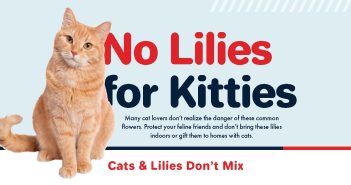Most of us know that exposure to household toxins like asbestos can lead to mesothelioma in humans; animals are just as susceptible to common hazards. Understanding that there are hidden dangers lurking around their house, pet owners can keep their furry friends safe, healthy and ultimately protected.
Need Help Right Away?
If you think your pet has ingested something toxic, contact the ASPCA Animal Poison Control Center immediately at (888) 426-4435.
Most pet owners know to keep dangerous materials away from their animals such as cleaning supplies, people food and antifreeze, because any inquisitive pet easily ingests those items. However, there are more household items overlooked by pet owners that are equally as dangerous that a pet may ingest or inhale.
Household garbage poses the single, largest threat to any pets’ health. Animals are drawn to the smelly refuse, typically looking for delicious scraps of people food left over. Especially with dogs, picking through the trash to find the tastiest bits is not practical; instead, any trash that smells good is munched.
This is a terrible hazard since garbage cans hold a smorgasbord of household waste including medications, paper towels used for cleaning, and even batteries. Broken glass, say from a light bulb, can cut an animals’ gums or tongue, and can cause horrible damage to the esophagus or stomach if swallowed.
Many pet owners do not know the threat airborne toxins can have on their furry shadows. Inhalation of any toxin, like bleach vapors, secondhand smoke or paint fumes not only have damaging health risks for people, but also for pets. Animals are naturally curious, exploring the world through their sense of smell or taste, simply investigating what their owners are doing can be risky.
Most pet owners understand the dangers cleaning supplies can pose for their animals, but what is often missed are the hazards of home renovations. Construction dust, insulation particles, asbestos or mold, common side effects of any renovation project, are also unsafe for animals.
Anything that is toxic for people is also toxic for pets. This overlooked hazard can often cause silent, yet deadly diseases in pets. Especially with inhaled toxins, animals can develop respiratory problems, circulatory disorders or cancer.
Ways to Keep Your Pet Safe
Simply, if it is unsafe or unhealthy for humans, it is also for animals. By following a few easy rules, any pet owner can keep their animals happy and healthy.
• Keep trashcans securely covered.
• Do not put unused or expired medications in the trash or down the drain. Many communities have safe ways to get rid of medications through local refuse collection sites.
• For cleaning or renovation projects, wear a protective mask and coverings, have proper ventilation and keep pets away.
• Do not leave any hazardous items on the floor, counters, tables or anywhere a pet can easily access.
• Keep dangerous products, like cleaning supplies, renovation materials or unsafe people food in a locked cabinet. Since many pets are able to open cabinets easily, attach child locks.
• For any extended home renovation including painting, tiling, wallpapering, sanding or refinishing surfaces, keep pets out of the house. If the renovation lasts more than a day, keep pets at a friend’s house or a kennel. Animals can not only ingest or inhale hazardous materials, there is also a threat of animals stepping on nails, glass, insulation or broken tile.
• Always inspect pets’ mouths, eyes, ears and feet to see any telltale signs of naughty behavior.
The most important way pet owners can protect their furry friends is to use common sense. Remember “If it is dangerous for me, it is dangerous for them.” For many pet owners, having an inquisitive shadow is so common that sometimes they can forget what they are doing may not be healthy for their animals.
By keeping a watchful eye on your curious friend, you can keep them safe and healthy. If you suspect that your pet ingested or inhaled a toxin, seek immediate veterinary care.
This article was submitted by Jack Bleeker.
Jack joined the Mesothelioma Cancer Alliance in 2005 as a research assistant after earning his bachelor’s degree in English with a focus on technical and medical research. He now oversees all web content production and authoritative processes, including HONcode accreditation, and supervises a team of medical writers. Jack continues to contribute to mesothelioma awareness and outreach efforts. He can be reached at jbleeker@mesothelioma.com.





4 Comments
Thanks for the information you provided in your article on household toxins. This is one of the biggest areas overlooked a lot by pet owners.
r/,
Pets Global Supply
Animal toxins that are sometimes no symptoms until it came out sick. Rabbit as a pet, but the most sensitive to toxins, so I need special care.
Awesome post with excellent information.
I agree, this is one of the most overlooked areas of pet care.
Happily, our families only emergency regarding this was a half a box of my son’s crayons which made for a colorful morning walk!
Happy holidays,
CC
I totally agree. That’s why even though my rabbits have their rabbit hutches, I make it a point to keep anything that could potentially harm them far.